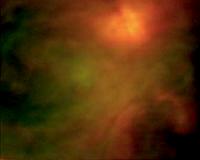 |
Pasadena CA (SPX) Dec 10, 2010 The Large Binocular Telescope Interferometer has taken its first images of the star Beta Peg in the constellation Pictor - an encouraging start for an instrument designed to probe the cosmic neighborhoods where Earth-like planets could exist. Eight years in development, the NASA-funded instrument combines beams of light from twin 8.4-meter (28-foot) mirrors mounted atop the Large Binocular Telescope on Mount Graham, Ariz. "By combining the light of the telescopes, we're able to realize its full potential," said Project Manager Tom McMahon of the University of Arizona, Tucson. "Together, the two mirrors form the largest single-mount telescope in the world." "The quality of the first-light images is wonderful," said the principal investigator for the project, Phil Hinz of the University of Arizona. "The telescope was stable and the instrument was working properly." With this high-resolution imaging capability, astronomers hope to probe nearby solar systems - specifically, the areas in these systems where Earth-like planets with liquid water could exist. Though the Large Binocular Telescope Interferometer won't be able to detect Earth-size planets, it will be able to see dust disks that are indicative of planet formation, in addition to detecting large, Jupiter-size planets farther out from the star. These findings will help future, space-based exoplanet missions know where to search for Earth-like planets in our own galactic neighborhood. With its ability to probe this "habitable zone" of other solar systems, the Large Binocular Telescope Interferometer will also complement the capabilities of other NASA missions - the Keck Interferometer, which can find dust very close to stars; and the Spitzer Space Telescope, which is adept at observing planet-forming dust that is much more distant. "This instrument will help complete our picture of what planetary systems look like and be a pathfinder for finding Earth-like planets that are close by," Hinz said. With a major upgrade of the Large Binocular Telescope's adaptive optics system scheduled for next year, the interferometer will undergo testing and commissioning for the majority of 2011, and during that time, scientific observations will begin. "This is the highest-resolution instrument of its kind in the world," McMahon said. "We won't just be able to image exoplanets, but extragalactic objects, nebulae and galaxies. It's taken time to make sure it works as envisioned, but now it's time to do science." The Large Binocular Telescope Interferometer is funded by NASA and managed by Ben Parvin at NASA's Jet Propulsion Laboratory, Pasadena, Calif., as part of NASA's Exoplanet Exploration Program. The instrument and product development are provided by the University of Arizona, Tucson.
Share This Article With Planet Earth
Related Links Large Binocular Telescope Interferometer Space Telescope News and Technology at Skynightly.com
 First Scientific Flight For The SOFIA Airborne Observatory
First Scientific Flight For The SOFIA Airborne ObservatoryBonn, Germany (SPX) Dec 02, 2010 The Stratospheric Observatory for Infrared Astronomy, SOFIA, a joint project of NASA and the German Aerospace Center (Deutsches Zentrum fur Luft- und Raumfahrt; DLR), has commenced scientific operations. SOFIA took off on its first scientific observation flight on 30 November 2010 at 19:34 hrs local time, from the NASA Dryden Aircraft Operations Facility in Palmdale, California. The subjec ... read more |
|
| The content herein, unless otherwise known to be public domain, are Copyright 1995-2010 - SpaceDaily. AFP and UPI Wire Stories are copyright Agence France-Presse and United Press International. ESA Portal Reports are copyright European Space Agency. All NASA sourced material is public domain. Additional copyrights may apply in whole or part to other bona fide parties. Advertising does not imply endorsement,agreement or approval of any opinions, statements or information provided by SpaceDaily on any Web page published or hosted by SpaceDaily. Privacy Statement |